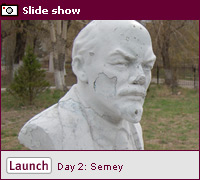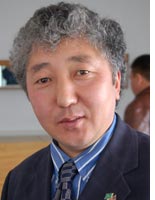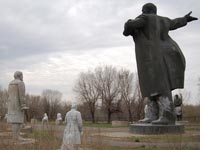A Nuclear Family Vacation in Russia
SEMEY, Kazakhstan—"Hello Slate magazine, you are welcome in Semipalatinsk!"
With his curly hair and rotund figure, the Kazakh man greeting us at the regional airport was a dead ringer for North Korea's fearless leader. Though we eventually learned his name was Aidar, we had a hard time thinking of him as anyone other than Kim Jong-il.
Perhaps it was because we grew convinced he wanted to kidnap us.
Aidar worked in the international section of the akimat, or mayor's office, of Semipalatinsk, a city of around 400,000 in northeastern Kazakhstan. His mission, as we came to understand it, was to ensure that we never left the city—or at least not until we had absorbed every fact and figure he had memorized about his beloved hometown.
Semipalatinsk is the old Russian name for a city czarist officers once called the "devil's sandbox." The Kazakhs now call it Semey, which Aidar helpfully translated as "soul place."
During the Cold War, Semipalatinsk was downwind from the Soviet Union's main atomic test site. Today, the city occupies a central place in Kazakhstan's national narrative. A glossy brochure issued by the Kazakh Embassy in Washington summarized it well, describing a country that suffered from nuclear testing but selflessly agreed to surrender its nukes after the collapse of the Soviet Union. The Kazakh people, the brochure said, "were used as guinea pigs during almost 500 nuclear explosions carried out by the Soviets."
The same brochure featured a ghoulish image from the Semipalatinsk medical museum: a one-eyed baby floating in formaldehyde. The picture could represent many things: a horrific consequence of nuclear fallout, a tragic birth defect unrelated to radiation, or a major lapse in taste.
For Semipalatinsk, that is the paradox: How do you play up your nuclear victimhood without driving away visitors?
It wasn't a hard sell for Aidar. He wanted to share his vision of Semipalatinsk, a city that had so much to offer the outside world ("museum of miniature dolls," "Dostoyevsky house," "famous mosque"). For the duration of our stay, he was like a third hand: forever present, reluctant even to part in the evening.
Our first stop on the nuclear tour was the memorial to the victims of atomic testing. Called "Stronger Than Death," this gargantuan public sculpture featured a granite woman kneeling protectively over her child. Hovering overhead was the silhouette of a mushroom cloud. The sculpture reflected the Soviet taste for the literal in public art.
But what effect did five decades of nuclear testing really have on the local population? Were high cancer rates and birth defects a direct result of radioactive contamination? At our next stop, the Semipalatinsk Institute of Radiation Medicine and Ecology, answers were frustratingly elusive.
When the institute was founded during the Communist era, its main task was not to provide treatment for fallout victims but to dispatch top-secret reports to the Institute of Biophysics in Moscow. Today it serves the public. With some help from the Japanese, the institute has created a database on more than a quarter of a million people affected by testing. Researchers focus on understanding the effects of radiation; documents rescued from Soviet times, once marked top secret, now feed into their studies. They conclude the region has an elevated cancer rate.
"Not all pathologies can be attributed to the after-effects of radiation," said Boris Gusev, director emeritus of the institute. "Unfortunately, our region also has heavy industry. More than half of illnesses can't just be attributed to radiation, it's the overall ecological situation. We don't try to encourage hysteria, and we take a realistic and objective approach to the whole problem."
On our way to the next appointment, Aidar's monologues continued. There was Aidar on Afghanistan ("They didn't appreciate what the Soviets did for them"); Aidar on Islam ("Muslims can eat pork. When the Quran was written, we didn't know about modern sanitation"); and, our personal favorite, Aidar on the Soviet era ("Not altogether a bad thing"). Happy to have captive English speakers on hand, Aidar gave us sections of his Web site to edit between interviews. He hoped the site would eventually draw tourists to the many fine museums and monuments of Soul Place—as well as to the nuclear test site.
"A short visit will not pose any danger to human health, rather the pervasive atmosphere will give you an emotive impression of the tragedy," read his proposed text.
Our next visit was to the office of the local administration. The mayor was busy, but we met his chief of staff, Yerlan Maikenov, along with a gaggle of local reporters who had been summoned to cover his meeting with foreign journalists. Maikenov began by reading us a speech about the trauma of nuclear testing. When we asked him for his thoughts on nuclear weapons, we got his first unscripted response.
"Well, I'm a peaceful person, I don't even like to hold a knife," he said. "But of course if you must defend yourself ..." He paused for a moment before remembering the party line: "I must bow before our president, who made the wise decision to turn away from nuclear weapons."
On our way back to the hotel, Aidar continued on the delights of Soul Place ("beautiful botanical garden," "children's zoo," "nice rivers"). We passed on his offer of evening entertainment ("I can offer a night excursion, town square, music disco") but found that the city had other diversions as well. At the Hotel Semey, we went on an unsuccessful hunt for toilet paper.
"Do you wish to relax?" chirped a friendly young prostitute in the hall.
The next morning, we considered telling Aidar we might skip the day's attractions and go directly to the airport. But we remembered one important thing: We hadn't yet seen the one-eyed baby.
After arriving at Semipalatinsk State Medical Academy, we were ushered past a reliquary of Lenin statues and into a small two-story building. The museum—a single room, really—was lined with jars of deformed fetuses. It was a real horror show: encephalitic heads, misshapen bodies, and missing limbs. And there, floating in formaldehyde, was the one-eyed baby from the embassy brochure.
"It's the only Cyclops baby in any museum," the caretaker proudly informed us.
Staring at the display, we suddenly felt like rubberneckers at a catastrophic car accident. It was time to catch our plane.
On our trip to the airport, we got another lecture—on the local churches ("beautiful"), on Dostoyevsky ("spent wonderful time in Semipalatinsk"), on the future of Kazakhstan ("we hope not all good things from Soviet era are lost").
At the airport, Aidar was not ready to let us go. He followed us through security and twice waved off a guard who insisted he leave. Whatever his faults, Aidar was an embodiment of Kazakh hospitality and national pride. In guiding us around Semipalatinsk, he showed us a country that was proud of its independence, if still a bit confused over its national identity.
We worked hurriedly to finish editing Aidar's text on local culture, which touched on the neglected beauty of Soviet-era architecture and public art. We concentrated on the final passage:
While you stay in Semipalatinsk, the city with blended old and new, with ancient history, the city bathed in green, you will spend an unforgettable time and I am sure that you will try to make your own contribution to the economic development of the land which suffered from nuclear testing.
We handed the piece back to Aidar, and airport security escorted him out.


